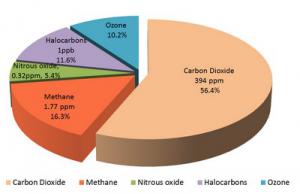ClimateGreenhouse gas concentrations in the atmosphere hit another record
The amount of greenhouse gases in the atmosphere reached yet another new record high in 2014, continuing a relentless rise which is fueling climate change and will make the planet more dangerous and inhospitable for future generations, according to the World Meteorological Organization (WMO). The pre-industrial level of CO2 — of about 278 ppm — represented a balance between the atmosphere, the oceans, and the biosphere. Human activities such as the burning of fossil fuels has altered the natural balance, and in spring 2015, the global average concentration of CO2 crossed the 400 ppm barrier. The global annual average is likely to pass 400 ppm in 2016.

Graph showing distibution of atmospheric gases // Source: fau.edu
The amount of greenhouse gases in the atmosphere reached yet another new record high in 2014, continuing a relentless rise which is fueling climate change and will make the planet more dangerous and inhospitable for future generations, according to the World Meteorological Organization (WMO).
The World Meteorological Organization’s Greenhouse Gas Bulletin says that between 1990 and 2014 there was a 36 percent increase in radiative forcing — the warming effect on our climate — because of long-lived greenhouse gases such as carbon dioxide (CO2), methane (CH4), and nitrous oxide (N2O) from industrial, agricultural and domestic activities.
WMO reports that its study also highlights the interaction and amplification effect between rising levels of CO2 and water vapor, which is itself a major greenhouse gas, albeit short-lived. Warmer air holds more moisture and so increased surface temperatures caused by CO2 would lead to a rise in global water vapor levels, further adding to the enhanced greenhouse effect. Further increases in CO2 concentrations will lead to disproportionately high increases in thermal energy and warming from water vapor.
“Every year we report a new record in greenhouse gas concentrations,” said WMO secretary-general Michel Jarraud. “Every year we say that time is running out. We have to act NOW to slash greenhouse gas emissions if we are to have a chance to keep the increase in temperatures to manageable levels.”
Atmospheric concentrations of CO2 — the most important long-lived greenhouse gas — reached 397.7 parts per million (ppm) in 2014. In the Northern hemisphere CO2 concentrations crossed the symbolically significant 400 ppm level in 2014 spring, when CO2 is most abundant. In spring 2015, the global average concentration of CO2 crossed the 400 ppm barrier.
“We will soon be living with globally averaged CO2 levels above 400 parts per million as a permanent reality,” Said Jarraud
“We can’t see CO2. It is an invisible threat, but a very real one. It means hotter global temperatures, more extreme weather events like heatwaves and floods, melting ice, rising sea levels and increased acidity of the oceans. This is happening now and we are moving into uncharted territory at a frightening speed,” he said.
“Excess energy trapped by CO2 and other greenhouse gases is heating up the Earth surface which leads to increase in atmospheric water vapor which in turn is generating/trapping even more heat,” said Jarraud.
